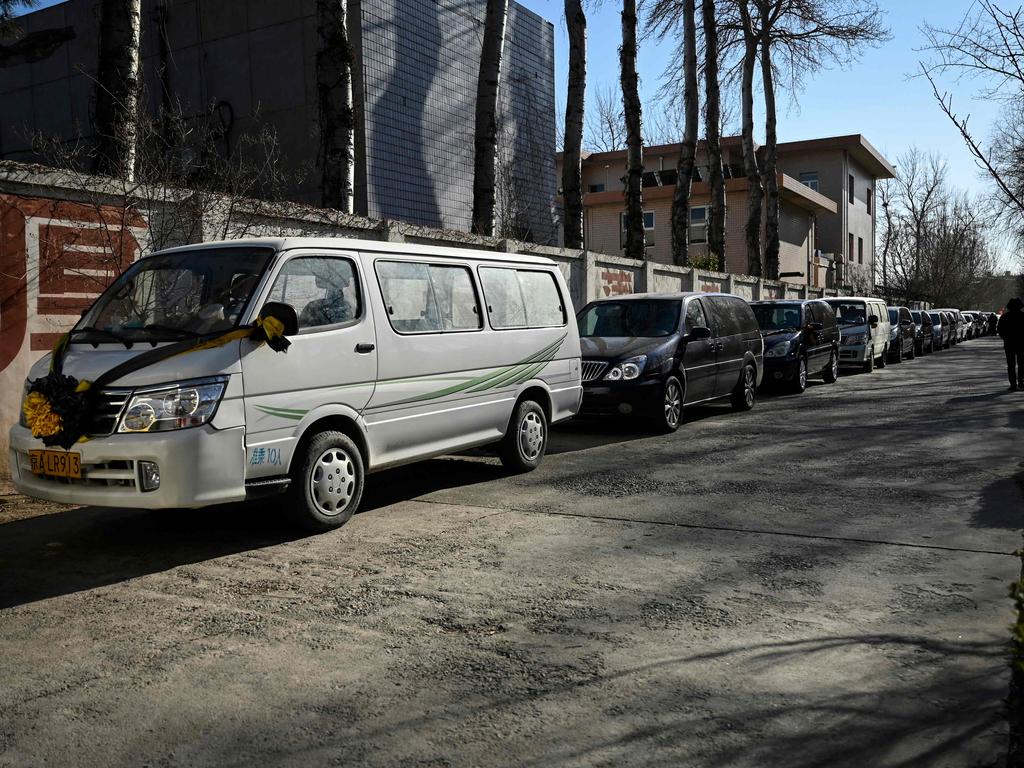Images reveal a new funeral car park built as China’s Covid deaths soar
Unsettling satellite imagery taken above China’s capital, Beijing, reveals the scale of a crisis the government is trying to keep quiet.

Disturbing satellite imagery has shown a funeral home in Beijing clearing the way for more bodies to arrive, revealing the true scale of China’s Covid crisis at a time when the country’s government is trying to downplay the situation.
In the images, which were shared by Maxar Technologies, a grassy patch of land is seen cleared and paved over to make way for a new car park, with the plan rushed through in less than three weeks.
By Christmas Eve, the car park housed more than 100 cars, with more piling up on the street and inside the facility walls – a stark contrast to the quietness of the facility just a few weeks earlier.
EXCLUSIVE: Satellite imagery and newly verified footage show packed crematoriums across China as covid surges — suggesting the country's death toll is far higher than the government says. https://t.co/nVEyurTFIH
— Samuel Oakford (@samueloakford) January 9, 2023
In separate images and videos, other funeral homes were seen with lines of cars stretching across city blocks and crowds of people gathered on foot. Many of the clips showed lines of large white vans, which are typically used as hearses.
While a surge in demand for end-of-life services is common over winter, the images show a staggering increase even compared with previous years.
Funeral homes struggle with unmanageable demand
Funeral homes across the country reported unmanageable demand for their services.
“I have worked here for six years and it has never been this busy,” a receptionist at the Jiangnan Funeral Home in Chongqing in southwest China told the Washington Post.
“The phone has basically not stopped ringing.”
Some funeral homes said they had stopped offering memorial services altogether, allotting just a few minutes for each family to grieve.

According to British-based firm Airfinity, 9000 people are likely dying from Covid in China every day.
Eighty per cent or more of Beijing’s population was estimated to be infected by the virus by the end of December.
And nearly 90 per cent of people in Henan - China’s third most opulous province - have had Covid, health officials said. That’s around 88.5 million people.
Meanwhile, the Chinese government continues to claim that fewer than 40 people have died in China from Covid since December 7, when the country’s Zero Covid policy was abruptly abandoned after years of fighting to keep it in place.
Chinese President Xi Jinping lifted the draconian measures amid fierce protests across China which intensified after 10 people died in a unit fire.
There were allegations firefighters were delayed from entering the apartment block due to a quarantine order, and the protests spread to at least nine cities countrywide.
Officially, just over 5200 people – of China’s huge population of 1.2 billion – are reported to have died of Covid since the pandemic began.

Chinese state media fights back against reports
In a vicious retaliation to criticism delivered on Monday, the People’s Daily – a news source that largely serves as a mouthpiece for the Chinese Communist Party – defended China’s approach.
“China follows a science-based approach in preventing and controlling COVID-19 and has been constantly finetuning its response measures in light of the evolving situation,” the piece insisted.
“It is generally believed by international personages that China’s COVID-19 response is based on its understanding of the laws of how the virus evolves and spreads, and mirrors the country’s commitment to seeking truths through scientific approaches.”
The international community, by contrast, has called for transparency as it expresses serious concern over the crisis.
“In China, what’s been reported is relatively low numbers of cases in ICUs, but anecdotally ICUs are filling up,” WHO emergencies director Mike Ryan said in December.
He gave Beijing the benefit of the doubt, adding: “I wouldn’t like to say that China is actively not telling us what’s going on. I think they’re behind the curve.”

Concern for Aussie manufacturing
Last week, a senior economist warned the flow-on effects from the surge could wreak havoc on Australia’s economy, as supply chain failures threaten a slew of major industries.
“After decades of Australia outsourcing so much manufacturing to China, we’ve made ourselves so much more vulnerable to China’s trade policy, health policy, health outcomes and everything else,” Australia Institute Executive Director Richard Denniss warned.
China’s top health bureaucrats promise the country will release more accurate death statistics – just not yet.
Liang Wannian, a top adviser on the government’s coronavirus response team, said at a news conference late last month that authorities would only be able to investigate Covid deaths after the current wave. Wu Zunyou, chief epidemiologist at the Chinese Center for Disease Control and Prevention, added that the centre had been analysing excess mortality rates, but would release the results at a later date.






